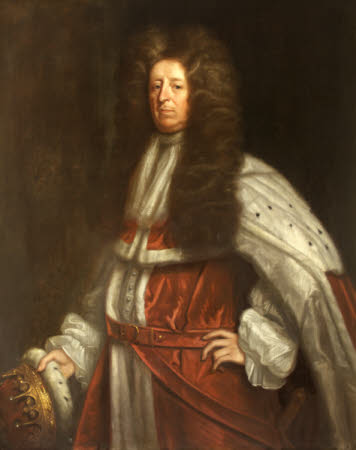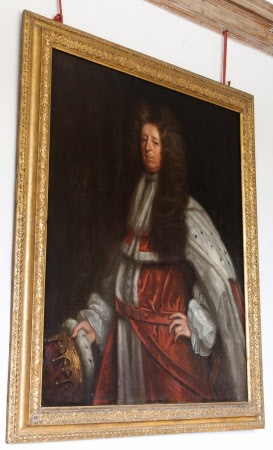Richard, 2nd Viscount Lumley & 1st Earl of Scarbrough (c.1650 - 1721), in the robes of an Earl
manner of Jonathan Richardson the elder (London 1665 – London 1745)
Category
Art / Oil paintings
Date
circa 1700 - 1710
Materials
oil on canvas
Measurements
1257 x 991 mm (49 1/2 x 39 in)
Place of origin
England
Order this imageCollection
Lacock, Wiltshire
NT 996327
Caption
The sumptous robes worn by the sitter are an expression of his elevated title. The mixture of red velvet, ermine and the gold coronet are a conspicuous display of wealth and power. The artist has not slimmed down this eminent figure and his red velvet belt only just reaches around his ample girth. However, his face is noble and expressive and the artist has painted his features with more sensitivity than the robes, which are much more freely painted.
Summary
Oil painting on canvas, Richard, 2nd Viscount Lumley and 1st Earl of Scarbrough (c.1650 - 1721) in the Robes of an Earl, manner of Jonathan Richardson the Elder (1665 - 1745), circa 1700/1710. A three-quarter-length portrait of an unknown man, turned to the left, wearing crimson and ermine robes, with a long wig, his left hand on his hip, and his right hand holding an earl's coronet.
Full description
Richard (Lumley), 2nd Viscount Lumley of Waterford (Irish Peerage) & 1st Earl of Scarbrough (English peerage) (c.1640 – 1721) was only a collateral descendant of the celebrated, genealogically-obsessed, portrait collector, John, Baron Lumley (c.1533-1609). He instead succeeded in 1663 to the title conferred on his grandfather, Richard Lumley, of Lumley Castle, in 1628, his father, the Hon. John Lumley (†1658) having predeceased his own father. His mother, Mary Compton, daughter of co-heir of Sir Henry Compton, K.B. was still alive in 1666. Richard was educated as a Catholic, for which (concealed) purpose he “went beyond seas” in 1654. Returning to England at the Restoration, he became a favourite of Charles II’s – but perhaps eventually even more of Queen Catherine of Braganza’s, since from 11th September 1680 to 23rd February 1681/2 he was her Master of the Horse, and on 25th October 1684, her Treasurer. On 31st May 1681 his Irish peerage was strengthened by an English one, as Baron Lumley of Lumley, meaning that he could sit in the English House of Lords. His military experience began when he took part in the abortive expedition to Tangier (part of Catherine of Braganza’s dowry) in 1680. When Monmouth’s Rebellion broke out he raised a troop of horse in Hampshire and several troops of Sussex militia, and captured Monmouth on 8th July 1685. Out of these, he formed a regiment of carabiniers – later the 6th Dragoon Guards – of which he became colonel. Dissatisfaction with James II’s policies, however, impelled him to lay down his commission and turn Protestant, in 1687. He entered into communication with William of Orange’s friends, supported the Seven Bishops, and was a signatory to the invitation to William to depose James. On William’s invasion, he was sent to secure the North, and seized Newcastle. His rewards were to be made a Privy Councillor on 14th February 1688/9, a Gentleman of the Bedchamber on 23rd February, Colonel of the 1st Troop of Horse Guards on 2nd April, and Lord-Lieutenant of the Counties of Durham and Northumberland the same year. On 10th April 1689, he was created Viscount Lumley in the English peerage, and on 15th April 1690 Earl of Scarbrough in the same. He served at the Battle of the Boyne and in Flanders, before retiring from active service after the Peace of Ryswyck (1697). He served both Queen Anne and George I, ending up sharing the Vice-Treasureship of Ireland. He married Frances, daughter of Sir Henry Jones of Aston, Oxfordshire, when she was only about 19, and the ward of John Talbot of Lacock. They had 7 sons and 6 daughters. He was succeeded by his second son, also Richard, who was made K.G. in 1724, and became a lieutenant-general in the army. He committed suicide, the day before he was due to marry a famous beauty, Lady Isabella Montagu (‘Belle’), fresh widow of the 2nd Duke of Manchester, so the title then passed to his younger brother, Thomas Lumley-Sanderson, from whom the present Earl descends. The identity of the Earl in this portrait remained unknown, until an enquiry by Sir John Guinness in 2010 (see Related objects) prompted research into it. It seemed to emerge from that that the one earl of whom a portrait might plausibly have been inherited by the Talbots of Lacock was Talbot, 1st Earl of Sussex (1690 – 1731). The fact that another version of the portrait had belonged to the Lords Lilford seemed to reinforce this identification. If the identification as the 1st Earl of Sussex is correct, it illustrates two dangers in identifying portraits: the one proceeding from estimates of apparent age (the sitter here looks older than in his late twenties), and the other from reliance on accepted dates of hairstyle and costume: one would normally – as the previous datings of this picture indicate – take the wig to denote some time in the first decade of the eighteenth century. There is a very similar portrait of Thomas, 6th Earl of Thanet (1644 – 1729) (cf. Erna Auerbach & C. Kingsley Adams, Paintings and Sculpture at Hatfield House, 1971, cat. no. 232, p. 200 & ill.149) inscribed as at the age of 75 – painted, therefore, in 1719 – and as by Closterman, who looks little, if any, older than the sitter in the present portrait, whilst the wig is of the same form and length in the two, but Auerbach & Adams, whilst accepting the attribution to Closterman (which they take to mean John [1660-1711], rather than his brother John Baptist [† 1713]), implicitly reject the inscribed date, saying: “The style of the wig is that of c.1700-10, and the Earl’s age near or probably over sixty.” Malcolm Rogers, whilst accepting their attribution of the non-pendant portrait of his wife to John Closterman, and dating it to the “? mid-1680s” (Auerbach & Adams, cat.no.233, p.200 & ill.150; Rogers, ‘John and John Baptist Closterman: A Catalogue of their Works’, The Forty-Ninth Volume of The Walpole Society, 1983, cat.no.100, pp.263-64) says of his portrait that: “though it is similarly inscribed [Auerbach & Adams record no inscription on her portrait, which they suggest may be ten years earlier], is much later in date and has nothing to do with Closterman.”
Provenance
not fully known, but probably given by the sitter to Sir John Talbot (1630-1714), as the guardian (until her marriage) of his wife, Frances Jones (b.c.1664/5; m.1684/5), and thence by descent to the offspring and subsequent heirs of Martha Talbot († 1790) and the Rev. William Davenport († 1781), to Matilda Theresa Gilchrist-Clark (1871-1958), who took the name of Talbot, and gave Lacock Abbey, its essential contents, and the village and estate of Lacock to the National Trust in 1944.
Credit line
Lacock Abbey, The Talbot Collection (National Trust)
Makers and roles
manner of Jonathan Richardson the elder (London 1665 – London 1745), artist British (English) School, artist previously catalogued as attributed to Michael Dahl (Stockholm 1659 - London 1743), artist

